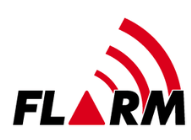
Every FLARM, whether classic, power or RedBox FLARM with RJ45 connection can be connected to the XCVario with standard cables. The cable available in the shop has the power option, with which the FLARM is also supplied via this cable. This saves additional wiring for the supply of the FLARM from the vehicle electrical system. Other FLARMs with RJ12 connector or Sub-D connector can also be connected with a modified cable.
If the FLARM is plugged in, the NMEA data from the GPS and barometric probe (if the FLARM is available) are sent to XCSoar with the FLARM cable as standard. With the bidirectional FLARM cable (see chapter Electrical connection /FLARM), tasks can also be written to an IGC-Flarm and settings of the FLARM can be made. See the description of XCSoar.
A flight download can also be carried out with the recorded flights in FLARM. To do this, the FLARM must be created as a separate device with the “FLARM” driver in XCSoar and activated for the download (Config/NMEA Connection/FLARM../Activate). During activation of the FLARM driver, other drivers such as OpenVario, which use the same Bluetooth connection, must be deactivated (Config/NMEA connection/OpenVario../Deactivate). The flight download can then be tapped in the FLARM device, a list of flights is first transmitted, from which the desired flight is then selected. The flight download via the serial interface can take a few minutes, depending on the length of the flight, since the data rate of the serial interface at the standard 19,200 baud only allows around 2 kilobytes per second. Higher data rates for faster downloading are possible, see the chapter on setting the baud rate of the serial RS232 interface. If XCSoar is connected via WiFi instead of Bluetooth, the FLARM can also be created as a separate device in XCSoar with the “FLARM” driver. It is then no longer necessary to create (or change) the device driver for the flight download or to switch to the Vario Setup menu. The flight download via the WiFi interface is possible with a WiFi device, which is connected via the Flarm port for the purpose. Other devices connected to the XCVario must be switched off during the download.
In the current software versions, there is also a simple FLARM screen to warn of an imminent collision with another aircraft, which graphically visualizes the distance, direction and height offset of the approach. Depending on the alarm level, an acoustic warning signal with an adjustable volume is also used to draw attention to the danger.





Hi All,
Is there just one file for the complete manual? The print function doesn’t work on my laptop, just flashes up and disappears before you can use it. Using system print dialog just prints the whole page which is over kill. Plus if you need it on the flight line you dont normally have a laptop/computer in your back pocket.
Cheers
Geoff
S/n 0217 (80mm)
You can save the relevant chapters to pdf and print e.g. 4 pages on one A4 as onboard manual if paper is really needed. Most are using just the online manual what works pretty well on a mobile.
Cheers.